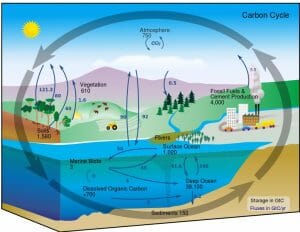The carbon cycle reservoirs on Earth interact with each other through chemical, geological, physical and biological processes. The exchange of carbon between the reservoirs is balanced so that carbon levels remain stable, except when it comes to the influence of humans. The largest reservoir of carbon on Earth is the oceans. Below are all the major carbon reservoirs on Earth and the approximate amount of carbon they have sequestered in them.
- Deep oceans = 38,400 gigatons
- Fossil fuels = 4,130 gigatons
- Terrestrial biosphere = 2,000 gigatons
- Surface oceans = 1,020 gigatons
- Atmosphere = 720 gigatons
- Sediments = 150 gigatons
The main activities of humans that cause additional carbon to enter the carbon cycle beyond the natural processes are the burning of fossil fuels and deforestation. The burning of fossil fuels released almost 10 gigatons of carbon into the atmosphere in 2015.

The image above shows Earth’s carbon cycle and the associated carbon reservoirs.
References
- Carbon Cycle. (n.d.). In Wikipedia. Retrieved September 11, 2017 from https://en.wikipedia.org/wiki/Carbon_cycle
Carbon Cycle Reservoirs
No comments:
Post a Comment